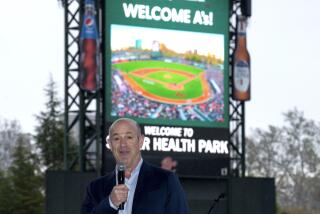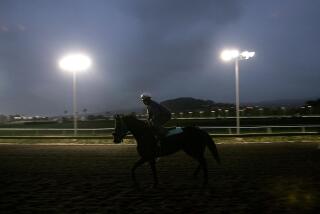MAJOR CHANGES IN THE MINORS : Independent Streak Pays Off at Pro Baseball’s Lower Levels : Valley Region Could Get Caught Up in Revived Popularity
A fan recognized the bespectacled 6-foot-6 right-hander, a popular member of the Houston Astros pitching staff for three seasons. The Astrodome is located just up the road a spell, 90 miles from Beaumont.
“Charley!” the fan said. “What the heck are you doing in Beaumont?”
Sometimes, Kerfeld asks himself the same question.
What’s cooking in Beaumont is brewing across the nation and Canada. Kerfeld is manager of the Beaumont Bullfrogs, a member of the Texas-Louisiana League, one of a growing band of independent leagues.
That Kerfeld and Co. have been playing three months yet remain a mystery in their hometown isn’t particularly surprising. The Bullfrogs didn’t exist until this summer, and more than a few folks aren’t sure what independent ball is all about.
That might change, eventually. In many locations, Independents Day has arrived or is just around the corner. Some teams will be real firecrackers, some duds.
In the baseball world, independents are anarchists. They are self-funded and have no major-league operating agreement, the financial umbilical cord for minor-league affiliates.
By this time next summer, as many as nine independent leagues could be playing across the baseball landscape, from Alexandria, La., to Zanesville, Ohio.
Independent leagues have found a niche and are seeking to exploit it. The appetite for minor-league baseball, despite distasteful labor strife at the big-league level, continues to grow in many parts of the country and independents are fueling the fire.
Strike? Who cares? Organizers of independent leagues gleefully boast that they have side-stepped the politics of affiliated baseball and exemplify the entrepreneurial spirit. No agents, prima donnas or lockouts. Just plain ol’ country hardball.
The San Fernando Valley region could soon catch the fever. The proposed independent Golden State League, based in Chatsworth, hopes to place a team in the Antelope Valley next summer. With key Palmdale officials throwing their support behind the project this month, the Golden State is closer than ever to gaining a crucial foothold.
The establishment of a team in the Valley region would erase a void that has existed almost without exception for 40 years.
The Ventura County Gulls, an affiliate of the Toronto Blue Jays and a member of the Class-A California League, played in 1986, then relocated. No other minor league team has played in the region since 1955.
The dearth of teams in other national quarters isn’t news to independent organizers. Research conducted by the Golden State League indicates that the number of minor league teams fell precipitously from more than 400 in 1950 to 144 in 1993.
The independents would dearly love to imitate the success of the Minnesota-based Northern League, which began play with a 72-game schedule last summer. Attendance in ’93 averaged 3,300 per game and the numbers this summer are even more positive.
In fact, the Northern League announced last week that with 29 dates remaining, it had drawn 797,993 fans, more than any short-season league in history. Six of eight teams in the first-year Texas-Louisiana League are averaging a respectable 1,450 nightly or better.
A boon only in the boondocks? Even independents in large cities have defied conventional logic and hit the jackpot. St. Paul of the Northern League drew a league-high 4,700 per game in ‘93, though it lies in the shadow of the Metrodome, the Minnesota Twins and Kirby Puckett.
Either a responsive chord has been struck in Minneapolis-St. Paul, or some franchise owners are going to lose their shirts. The Minneapolis Millers (Great Central League) and Minneapolis Loons (North Central) began play in the area this summer. Both are independents.
*
California’s baseball scene is considerably less saturated--at least for now. For all its fertile baseball ground, the state is represented in the minors only by the Cal League.
California has 30 million residents and 15 professional teams--including the Dodgers, Angels, San Francisco Giants, San Diego Padres and Oakland Athletics. By comparison, New York state has 15 pro teams, Florida 14 and North Carolina nine. All are smaller in population and geography.
The venerable Cal League, considered one of the nation’s best Class-A alignments, has teams in Bakersfield (Dodgers), Central Valley (Colorado Rockies), High Desert (independent), Lake Elsinore (Angels), Modesto (A’s), Rancho Cucamonga (Padres), Riverside (Seattle Mariners), San Bernardino (independent), San Jose (Giants) and Stockton (Milwaukee Brewers).
Competition for the Cal League baseball buck could soon be two-fold: The Western League, based in Portland, has announced its intention to field four teams in California in 1994, including franchises in Long Beach and Palm Springs. The Golden State hopes to field six teams in the state next summer.
Players on independent rosters are an eclectic mix. Most are undrafted free agents or players recently released by other organizations. Organizers insist the caliber of play is solid, and the way fans are filling the seats in many locations, something between the chalked lines has obvious appeal.
“There are an awful lot of good ballplayers out there,” said Miles Wolff, founder of the Northern League. “Each year, the big leagues sign a thousand players, so another thousand are pushed out.
“Some of those guys can play.”
And have played before. Many owners have signed former big leaguers to boost the gate. The Northern League includes former major league stars Leon Durham, Pedro Guerrero and Oil Can Boyd.
There could be a few diamonds among the retreads and castoffs. Infielder Mike Lansing of the Montreal Expos and pitcher Tom Candiotti of the Dodgers each played for independents.
The Texas-Louisiana League has taken a different tack. Each of its eight managers are former big leaguers, including Jose Cruz and Alan Ashby.
Cities generally have been receptive to the independents because eams help establish civic identity and give the local economy a shot in the arm. Bush league teams can mean a bushel of money.
According to estimates made by the National Assn. of Professional Baseball Leagues, an affiliated Class-A team generates an average of $4 million in revenue for its host city through taxes, hotel and restaurant usage, etc. The association is the governing body for 19 minor leagues. City fathers hope independents can generate a comparable economic windfall.
Brawley, an Imperial Valley city with a population of approximately 60,000, is exploring the possibility of joining the Golden State.
“We’re on the fast track with this,” said Tom Fox, director of the Brawley chamber of commerce and the city’s economic development commission. “It’s a good idea and we’re running some numbers. It could be a big help to the Imperial Valley and a big help to Brawley.”
The new teams have a familiar feel. In a manner of speaking, independents are a throwback to the days of flannel uniforms and jet-black spikes. In a simpler era, hundreds of small towns had independent teams to call their own.
The advent of extensive farm systems more than a half-century ago changed the minor-league landscape--at a hefty price to the major leagues. Big-league organizations instituted a multitiered player-development system that controlled players down to the Class-D level and essentially wiped out the independents.
Borrowing from the past, the independents may be the minor leagues’ wave of the future as cost-conscious big-league teams head into the 21st century.
Major league clubs--which often field three teams at the Class-A level alone--assume the financial burden for player development by paying for equipment, salaries of coaches and players, medical treatment, etc.
An operating agreement with a full-season Class-A team can cost the parent club $500,000 or more annually, one farm director said.
Conversely, an independent team pays its own expenses and sells player contracts to interested major league organizations. A big-league club would spend only a few thousand dollars annually on scouts, who would be responsible for plucking top players from the independent ranks.
“We’re the future of minor-league baseball in the lower classifications,” said Bob Weinstein, president of the Golden State League. “Scouts say it, coaches say it, Major League Baseball says it.”
Big-league clubs agree--to a point. In the 1930s and 1940s, before the extensive minor-league player-development systems of today were in place, clubs signed players from small independent teams located in almost every hamlet and burg in the country.
“What goes around comes around, I guess,” said Charlie Blaney, the Dodgers’ director of minor-league operations. “It’s certainly a possibility (that independents are the wave of the future), but I don’t see it in the near future. But there’s no question that everybody is looking for ways to save money.”
With the notable exception of player salaries, the major leagues have been lopping budgets for the past few years.
The Major League Scouting Bureau was pared. Umpiring crews this year were dropped from three to two in double-A leagues. The Montreal Expos, with the best record in the majors, trimmed their big-league advance scouting corps.
If this is a trend, keep it coming, say the independents. Bloated big-league salaries, strikes and organizational cutbacks make Weinstein and his brethren cackle.
“I got 28 owners I want to invite to my next cocktail party,” Weinstein said. “I want to stand up and tell them how much I appreciate their stupidity.”
Big league clubs have created an opening. Independents plan to carve a grand canyon.
Play Ball, California
Locations of existing California League baseball teams and proposed independent league franchise sites.
(graphic)
Independents Day
Independent leagues--minor league baseball without major league affiliation--might be the wave of the future in professional baseball. These grass-roots leagues are sprouting all over the country and in Canada, and the proposed Golden State League already has a toehold in Palmdale. A four-part series that begins today examines this national trend.
FRI.: The Golden State League, the brainchild of Chatsworth investment banker Bob Weinstein, is exploring the possibility of positioning teams in Palmdale, Vista, Brawley, Merced, Indio and an unspecified site in San Luis Obispo County. If everything falls into place, the leagues might begin a six-team, 90-game schedule as soon as next summer.
SAT.: Miles Wolff, who formerly published Baseball America magazine, last summer founded the first independent league--the highly successful Northern League. Attendance boomed and others took notice. Next summer, as many as nine independent leagues could be in operation.
SUN.: Independent leagues serve as a last chance for career minor leaguers and major league castoffs. One of the top hitters for the Sioux Falls (S.D.) Canaries of the Northern League is former Dodger Pedro Guerrero. Life at this rung in professional baseball is often unpredictable and humbling. Players are actually traded for bats and balls.
As Charley Kerfeld lumbered through downtown Beaumont, Tex., the chubby former big leaguer drew a curious stare.
More to Read
Go beyond the scoreboard
Get the latest on L.A.'s teams in the daily Sports Report newsletter.
You may occasionally receive promotional content from the Los Angeles Times.










